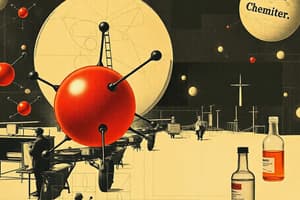Podcast
Questions and Answers
What is an atom?
What is an atom?
- The smallest unit of an element that still has the properties of that element (correct)
- The control center of a cell
- A subatomic particle with a positive charge
- A substance made up of two or more elements
What is a proton?
What is a proton?
A subatomic particle that has a positive electric charge.
What is the nucleus?
What is the nucleus?
The center of an atom, usually made of protons and neutrons.
What is a neutron?
What is a neutron?
What is an electron?
What is an electron?
What does atomic number refer to?
What does atomic number refer to?
Define an element.
Define an element.
What is a metal?
What is a metal?
What is a nonmetal?
What is a nonmetal?
What is a periodic table?
What is a periodic table?
What is a compound?
What is a compound?
What is melting point?
What is melting point?
What is boiling point?
What is boiling point?
Define plasma.
Define plasma.
What are isotopes?
What are isotopes?
What does fusion mean?
What does fusion mean?
What are molecules?
What are molecules?
What does malleable mean?
What does malleable mean?
Flashcards are hidden until you start studying
Study Notes
Atoms and Elements Study Notes
-
Atom: The fundamental unit of an element, retaining the element's characteristics.
-
Proton: Positively charged subatomic particle found in the nucleus of an atom.
-
Nucleus: The core of an atom, containing protons and neutrons; acts as the control center in cells.
-
Neutron: A subatomic particle with the same mass as a proton but lacks electric charge.
-
Electron: Negatively charged subatomic particle that orbits the nucleus and has negligible mass.
-
Atomic Number: Indicates the number of protons in an atom, determining the element's identity.
-
Element: A pure substance consisting only of one kind of atom, distinguished by its atomic number.
-
Metal: A class of elements known for their ability to conduct heat and electricity; typically malleable.
-
Nonmetal: Elements that do not conduct electricity well and are generally not malleable.
-
Periodic Table: A systematic arrangement of elements organized by increasing atomic number.
-
Compound: A substance formed when two or more different elements chemically bond together.
-
Melting Point: The specific temperature at which a solid transitions into a liquid.
-
Boiling Point: The temperature at which a liquid becomes a gas.
-
Plasma: A state of matter consisting of charged and uncharged atoms alongside free electrons.
-
Isotopes: Variants of the same element with the same number of protons but differing numbers of neutrons.
-
Fusion: The process of combining two or more entities into a single form.
-
Molecules: The smallest unit of a substance, either consisting of one type of atom (element) or multiple atom types (compound).
-
Malleable: A property of materials that allows them to bend and be shaped easily without breaking.
Studying That Suits You
Use AI to generate personalized quizzes and flashcards to suit your learning preferences.




